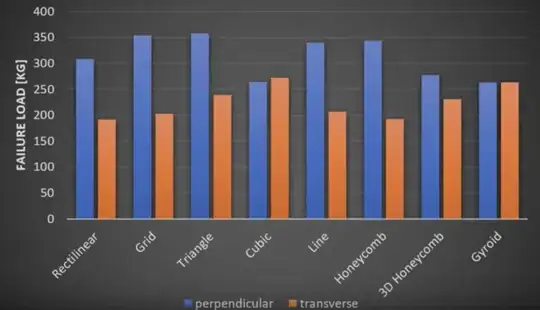I've seen a few print time-lapse videos lately which use gyroid infill: wavy lines, which deform across layers so that the waves end up alternating between the two axes. Other than making the time-lapse videos look much cooler, what are the benefits of this infill style compared to the more common hatching or cross-hatching?
4 Answers
From this reference you can read that:
A gyroid is a naturally occurring structure which be found in butterfly wings and even within membranes inside cells. In 2017, MIT researchers discovered that when graphene was shaped into a gyroid structure, it had exceptional strength properties at low densities. They then discovered however, that the crucial aspect of this was actually the gyroid structure itself, and that other materials such as plastic could benefit from this.
It is assumed that this type of infill has better properties against failure than the normal types of infill we know.
A test conducted by an author named Martin is found here. He printed test specimen and subjected them to bending to test the resistance against shear stress.
From the figure can be concluded that the gyroid infill has a better resistance against bending for a lower weight.
The advantages of gyroid infill over the tested infill types are:
- high shear strength, and
- low weight (so less filament needed).
On top of these advantages Gyroid infill prints relatively fast with respect to some other infill types and is close to isotropic (i.e. uniform in all orientations), meaning that is very suitable for flexible prints.
- 32,029
- 10
- 59
- 135
0scar gave a great answer, but I wanted to add to it.
Stefan of CNC Kitchen does a lot of 3D printer technique testing. He covered the gyroid and other patterns. While there's a difference in filament used, the significant differences are strength* and print speed. Here's his 8-minute infill pattern testing video; some screenshots follow. I stopped printing honeycomb once this video came out. Perhaps I should switch to gyroid too.
* yes, I'm calling it "strength". Don't at me, physics and materials science peeps, I know it's inaccurate.
- 373
- 1
- 10
-
1If I read this right, cubic and gyroid are the best 'all round' choices, and also gyroid has no clear lead? – Sean Houlihane Oct 05 '18 at 13:16
-
1correct, Sean. they seem really close. – tedder42 Oct 05 '18 at 14:48
-
2Benefit of Gyroid in contrast to cubic is, that gyroid never crosses itself in the same layer, while Cubic does. – Trish Feb 02 '19 at 11:32
-
A downside of gyroid that is not often mentionned is that it can make your 3D printer wobble quite a bit. – Nepoxx Jul 06 '21 at 13:36
This answer builds on to both 0scar and tedder42's answer:
Martin's experiment was about shear strength, where as Stefan of CNC Kitchen's experiment was about compressive strength on 2 directions.
From their experiments, it is reasonable to conclude that gyroid does well on sheer strength, and above mediocre on compressive strength.
Why use gyroid?
- If your print requires shear strength, use gyroid.
- Else if your print requires compressive strength from transverse or both directions, use cubic.
- Else if your print requires only perpendicular compressive strength, use triangle.
- If your print infill naked, each pattern has its own beauty.
See also:
Martin's experiment (Note how he used a bottle of water to test different structures for their shear strength):
https://www.cartesiancreations.com.au/gyroid-infill-tests/
Stefan of CNC Kitchen's experiment (Note how he used his self-made machine to compress different structures):
https://www.youtube.com/channel/UCiczXOhGpvoQGhOL16EZiTg
Examples of gyroid's aesthetics can be found in Matt's links:
-
For 2. I would use triangles: the low value is similar (there are no uncertainty bars in the graphs!) to cubic but on the strong direction is much better. And then 5. if you need speed, go rectilinear, which is still a very good compromise but quite faster. – FarO Feb 13 '20 at 16:04
About a decade ago, we looked at the 'Gyroid infill structure' (which we called sheet solid). We looked at it as a linear-elastic solid and as possible bone scaffold design:
https://www.sciencedirect.com/science/article/pii/S0142961211006776
What came out of that study that lots of the triply-periodic minimal surfaces (a broader class of structures that comprise the Gyroid) had interesting elastic moduli.
One thing that's worth noting though is that the Gyroid is not isotropic. Rather, it has cubic symmetry, ie 3 rather than 2 linear elastic constants. But it comes fairly close to isotropic
- 131
- 1
- 2
-
Many thanks for sharing the paper and the info. Good to know it is close to isotropic! – 0scar Jul 27 '19 at 23:38


